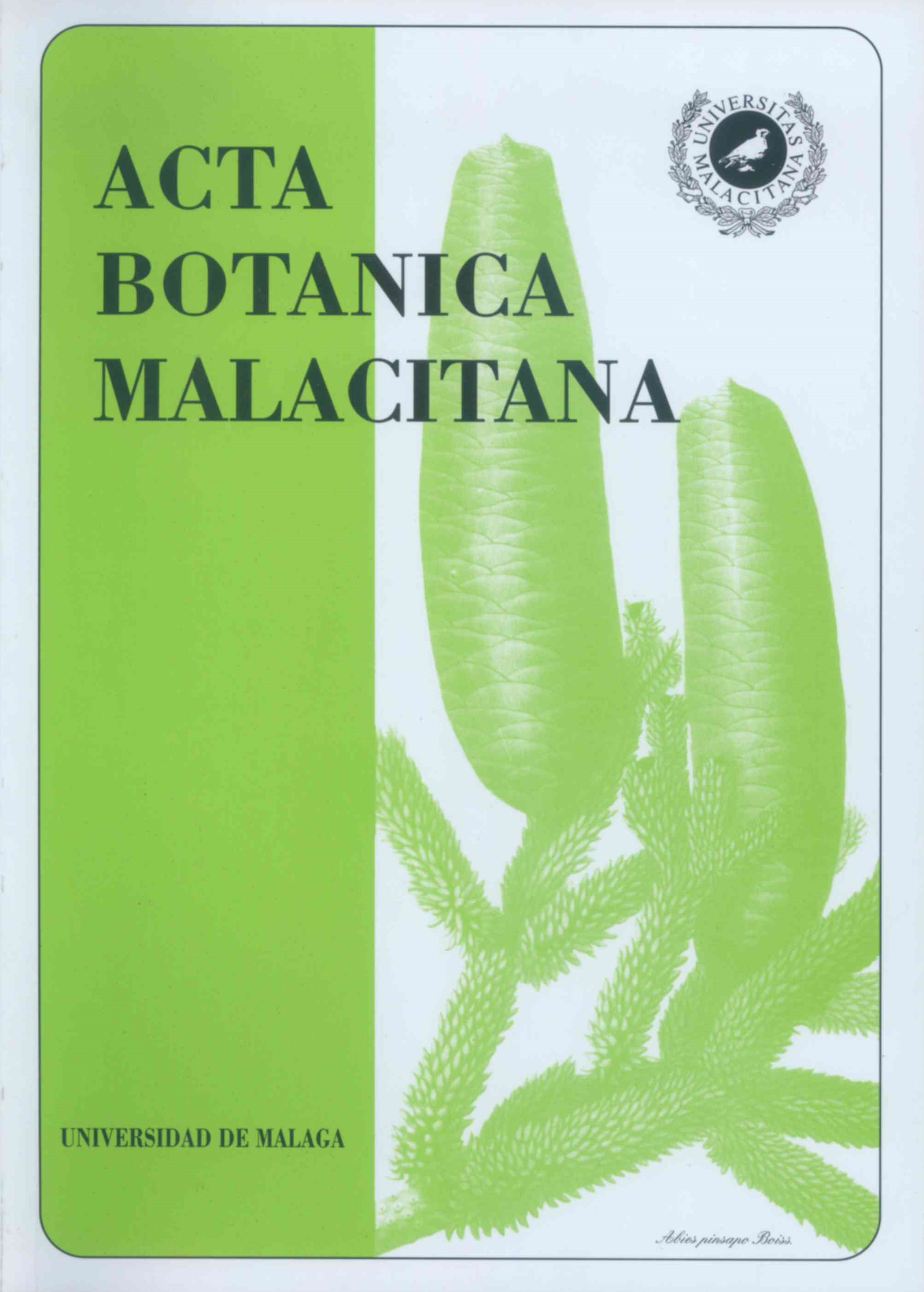Datos sobre la flora y vegetacio?n de la cuenca del ri?o Guadiamar (Sevilla-Huelva, Espan?a).
DOI:
https://doi.org/10.24310/abm.v27i0.7326Resumen
RESUMEN. Datos sobre la flora y vegetación de la cuenca del río Guadiamar (Sevilla-Huelva, España). Sc ha realizado un estudio florístico, fitocenológico y fitogeográfico de la cuenca hidrográfica del río Guadiamar (Sevilla-Huelva, Andalucía, España). Bioclimáticamente domina en la cuenca el piso termomecliterráneo (con un reducto mesomediterráneo al NW) y el ombrotipo subhúmedo (seco al S). Se propone una sectorización fitogeográfica para la cuenca a un nivel inferior al de sector y resaltando el papel de conector de la cuenca del Guadiamar entre la provincia Luso-Extremadurense (Sierra Morena) y la Tingitano-Onubo-Algarviense (arenales y marismas). Como resultado sobre la flora, se presenta un conjunto de especies de interés por estar protegidas, por su escasez en la cuenca, en Andalucía Occidental, o por indicar determinados ecosistemas frágiles o singulares. Respecto a la vegetación, el territorio presenta una gran diversidad de asociaciones y comunidades (96), algunas de ellas son novedades sintaxonómicas: Imperato cylindricae-Scirpetum holoschoeni, Cisto salvifolii-Ulicetum australis lavanduletosum sampaianae, Malcomio trilobae-Hytnenocarpetum hamosi loeflingietosunz baeticae, Ornithopi isthmocarpi-Anthoxantetum ovati y vulpietosum alopecuroris, Ranunculo peltati-Callitrichetum brutiae y Ranunculo hederacei-Callitrichetum stagnalis. Además se lectotipifican Polypogono monspeliensis-Ranunculetum scelerati y Scolymo maculati-Sylibetum mariani. Se han catalogado 13 series de vegetación, 5 de tipo climatófilo, dominadas por fagáceas (Quercus suber y Quercus rotundtfolia) con faci aciones de Pious pinea, Olea europaea var. sylvestris o Quercus broteroi, y 8 de tipo edafohidrófi lo (caracterizadas respectivamente por Populus alba, Fraxinus angustifolia, Ulmus minor, Alnus glutinosa, Salix pedicellata, Nerium oleander, Tamariz gallica y Securinega tinctorea). Así mismo, aparecen complejos edafogénicos (mosaicos) de vegetación halófila en Entremuros (Parque Natural de Doñana) y de vegetación dulceacuícola por toda la cuenca. La vegetación permanente edafoxerófila corresponde a Genistetum polyanthi. Se presentan un esquema sintaxonómico, tablas fitosociológicas de novedades y un mapa de las series de vegetación.
Palabras clave. Flora, vegetación, Fitogeografía, río Guadiamar, Sevilla, Huelva, Andalucía, España.
SUMMARY. Flora and vegetation in the basin of the Guadiamar river (Seville-Huelva, Spain). We have carried out a floristical, phytocoenological and phytogeographical study about the
Guadiamar river basin (Seville-Huelva, Andalusia, Spain). Thermo-mediterranean bioclimatic belt (appearing a little meso-mediterranean belt area towards NW) and sub humid ombro-type (dry towards S) characterises the basin. It is proposed a phytogeographical scheme under sector level for the Guadiamar basin. Stands out the corridor role of the Guadiamar river between the phytogeographical provinces Luso-Extremadurense (Sierra Morena) and Tingitano-Onubo- Algarviense (sandy lands and marshes). A group of species are highlighted as a result of being protected, rare in the basin or in Western Andalusia or because of living in fragile or singular ecosystems. Regarding the vegetation, a high diversity of plant communities has been found (96), some of them are new syntaxa or combinations: Impercaocylindricae-Scirpetumholoschoeni, Cisto salvifolii-Ulicetum australis lavanduletosum sampaianae, Malcomio trilobae- flymenocarpetum hamosi loeflingietosum baeticae, Ornithopi istlunocarpi-Anthoxantetum ovati and vulpietosutn alopecuroris, Ranunculo peltati-Callitrichetum brutiae, Ranunculo hederacei- Callitrichetum stagnalis. Two syntaxa are lectotypified here: Polypogono tnonspeliensis- Ranunculetum scelerati and Scolymo niaculati-Sylibetum mariani. 13 vegetation series have been recorded: 5 climactic, characterised by Quercus sober and Quercus rotundifolia showing variants with Pious pinea, Olea sylvestris or Quercus broteroi. 8 series are linked to riverside biotopes and respectively characterised by Populus alba, Fraxinus angustifolia, Ulmus minor, Alnus glutinosa, Salix pee/ice//ala, Nerium oleander, Tamarix gal lica and Securinega tinctorea. Halophytic vegetation (mosaics) is located in Entremuros near the Doilana marshes and also wetlands with hydrophilic vegetation are spread all over the basin. Soil-xeric permanent vegetation is represented by Genistetum polyanthi. A syntaxonomical scheme, phytosociological tables and one map of the vegetation series are also included.
Key words. Flora, vegetation, Phytogeography, Guadiamar river basin, Seville, Huelva, Andalusia, Spain.
Descargas
Métricas
Descargas
Publicado
Cómo citar
Número
Sección
Licencia
Toda la información relacionada con la licencia de uso de los trabajos publicados en Acta Botanica Malacitana y con los derechos de autor se pueden consultar en nuestra Política Editorial.







1.png)


